Understanding Gemstone Clarity and Its Value
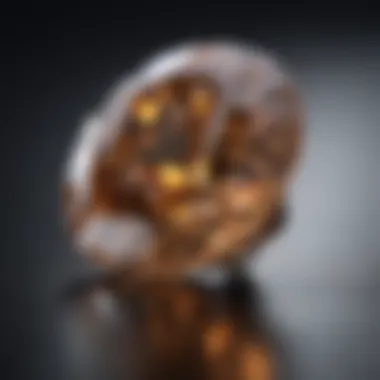
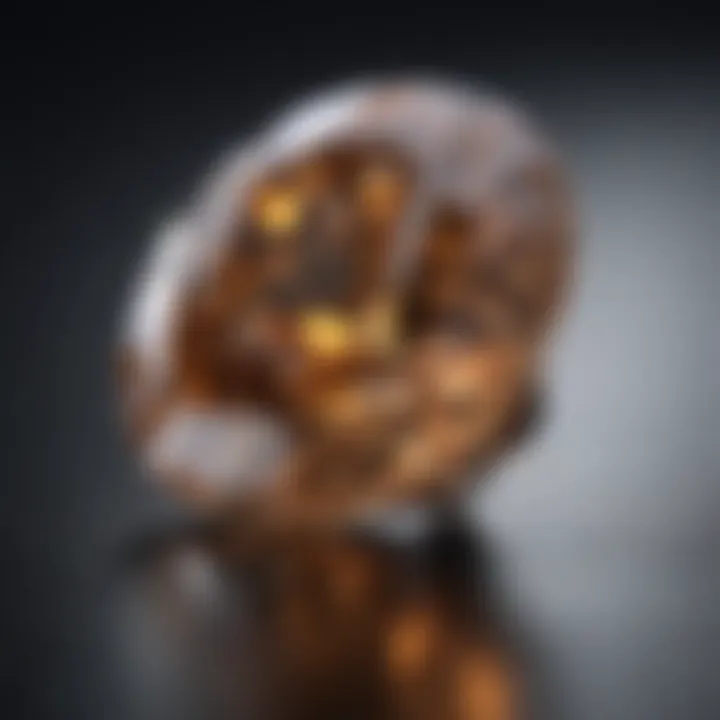
Gemstone Overview
Definition of Gemstones
Gemstones are naturally occurring minerals that have been cut, polished, and fashioned into various forms for jewelry and ornamentation. They come in a kaleidoscope of colors, shapes, and sizes, each possessing unique properties that are valued in the realms of aesthetics and investment. Beyond their beauty, gemstones carry a wealth of history and significance, making them fascinating subjects for deep exploration.
Classification of Gemstones
Gemstones can generally be classified into two main categories: precious and semi-precious gemstones.
Precious Gemstones include diamonds, emeralds, rubies, and sapphires. These are regarded as the crème de la crème of the gemstone world due to their rarity, quality, and historical value.
Semi-Precious Gemstones, on the other hand, include stones such as amethyst, citrine, and garnet. While not as rare or valuable as their precious counterparts, these stones still offer beauty and variety to jewelry and collectors alike.
Furthermore, gemstones can be categorized based on their chemical composition and crystal structure. For example, quartz is a common mineral that can take on many forms, from the clear, colorless varieties to the vibrant hues seen in rose quartz or smoky quartz.
Clarity in Gemstones
When discussing gemstones, clarity is a term that frequently emerges. But what does clarity really mean? Simply put, clarity refers to the presence or absence of internal or external imperfections, known as inclusions and blemishes. A gem's clarity can have substantial effects on its value. Higher clarity usually translates to higher prices.
The Dimensions of Clarity
It's important to understand that clarity is not only a measure of perfection but also influences how light interacts with the gemstone. A clear stone allows more light to pass through, enhancing its brilliance and sparkle, making it highly sought after. In contrast, stones with visible inclusions may capture light differently, sometimes leading to interesting glints and hues that reflect a unique character.
Historical Significance
Origins of Gemstone Use
The use of gemstones stretches back thousands of years. Historically, gemstones have been believed to possess magical or healing properties. Ancient civilizations in Mesopotamia, Egypt, and Greece made extensive use of gemstones for ornamental purposes, as well as for talismans and amulets.
Cultural Insights: Gemstones in Ancient Civilizations
In ancient Egypt, for instance, lapis lazuli was revered and often associated with the gods. Its deep blue color symbolized the heavens and the afterlife. Similarly, the Romans valued emeralds for their vibrant green color and believed them to represent fertility and rebirth.
"Throughout the ages, gemstones have not only adorned but also captivated humanity's imagination and spiritual beliefs."
Understanding the historical significance of gemstones can enrich one’s appreciation for them today. Not only do they vary in beauty, but they also tell stories of the cultures and eras from which they originated. For current collectors and enthusiasts, this historical context adds layers of meaning and value to each piece.
As we proceed, it’s crucial to explore how clarity is assessed, commonly held misunderstandings, and how clarity integrates with other gemstone qualities. This knowledge serves not only practical purposes for collectors but also deepens the cultural appreciation for these natural treasures.
Understanding Clarity in Gemstones
Clarity stands as a cornerstone in the realm of gemstones, wielding substantial influence over their value and allure. To grasp what clarity implies goes beyond merely identifying visible blemishes or inclusions; it intertwines with the very essence of a gemstone's quality and desirability. Here, we delve into the multifaceted aspects of clarity, examining how it shapes perceptions and decisions within the gemstone community.
Definition and Importance of Clarity
At its core, clarity refers to the presence of internal or external flaws in gemstones. Whether it's the tiniest speck of dust trapped during formation or a larger noticeable inclusion, these imperfections can dictate the overall beauty of a stone. It's important to recognize that clarity isn't simply about achieving perfection—many collectors cherish unique inclusions that tell a stone's story and provide character.
- Clarity serves as a key determinant in pricing. Generally, the fewer the flaws, the higher the stone's market value.
- It also affects how light interacts with the gemstone, influencing its brilliance and overall visual appeal. A clearer stone often exhibits a more vibrant sparkle, while inclusions may dampen that radiance.
In essence, clarity helps tell the journey of a gemstone, encapsulating its formation history and environment, which adds layers to both its scientific and aesthetic values.
Clarity Standards in the Gemstone Industry
In the gemstone industry, clarity is judged using specific standards derived from criteria established by organizations like the Gemological Institute of America (GIA). These guidelines employ a comprehensive grading scale, which aids gemologists and enthusiasts alike in objectively assessing gemstone clarity. Here's a brief overview of the common clarity grades:
- Flawless (F): No internal or external flaws visible under 10x magnification.
- Internally Flawless (IF): No internal inclusions, only minor surface blemishes.
- Very Very Slightly Included (VVS1 and VVS2): Minute inclusions that are difficult for a skilled grader to see under 10x magnification.
- Very Slightly Included (VS1 and VS2): Minor inclusions visible under 10x magnification but difficult to detect with the naked eye.
- Slightly Included (SI1 and SI2): Inclusions visible to a skilled grader under 10x magnification, and may be seen with the naked eye in SI2.
- Included (I1, I2, and I3): Inclusions that are obvious and may affect clarity and transparency.
“In the world of gemstones, clarity behaves like the silent judge; while it may not shout, its impact resounds through value and choice.”
Understanding these standards is paramount for buyers and collectors. It equips them to make informed choices, whether they are investing in high-end stones or simply pursuing personal pieces. Clarity clarifies not just the gemstone, but also the intentions and desires of those who seek them.
The Science of Clarity
Delving into the science of clarity in gemstones is not merely an academic pursuit; it plays a pivotal role in how we appreciate and assess these natural wonders. Understanding what contributes to clarity fosters a deeper appreciation among gemstone enthusiasts, collectors, and jewelry designers alike. Clarity influences a gemstone's beauty, value, and market demand, making this topic essential for anyone interested in the finer details of gemstone appreciation.
Formation and Natural Inclusions
Gemstones are often formed under conditions that give rise to unique characteristics, particularly inclusions. When we talk about the formation of gemstones, we often refer to the geological processes that take place over millions of years. These processes can create various types of inclusions. For instance, in diamonds, we can encounter carbon crystals or other minerals, which can add depth to the stone's character. Natural inclusions aren’t just seen as imperfections; they can serve as fingerprints, making each gemstone unique.
- Types of Inclusions: These can range from gas bubbles and liquid-filled cavities to other minerals trapped within the gemstone. Each type of inclusion tells a story about its journey through time.
Furthermore, these inclusions can genuinely enhance the aesthetic appeal for some collectors. A quartz crystal with vivid tourmaline needles might fetch greater interest than a perfectly clear counterpart. Thus, understanding inclusions can transform perceptions; rather than seeing them as flaws, appreciating them as markers of authenticity and history brings a richer context.
Technological Advances in Clarity Assessment
As our understanding of gemstones deepens, so too does the technology available for assessing clarity. Over the years, various advancements have led to more precise methods of evaluating clarity than ever before. Tools that once relied heavily on human observation now leverage sophisticated technology.
- Gemological Instruments: Devices such as 10x hand loupes, digital microscopes, and refractometers enable gemologists to examine stones closely and identify their internal features accurately.
- Spectroscopy: This method allows for the identification of different elements and compounds within a gemstone, thus indicating potential inclusions or structural flaws.
These technologies have made it possible for buyers to make informed decisions. For instance, a rare cola-colored diamond showing a distinct crystal structure might catch the eye of investors, but a detailed clarity report will inform them about its internal characteristics, potentially altering its market valuation.
These advancements mean that clarity assessments have moved from subjective views to more scientific evaluations, resulting in greater transparency within the gemstone market.
Factors Influencing Clarity
Understanding what impacts clarity in gemstones is pivotal for anyone who appreciates their beauty or considers them for investment. Clarity is not just an isolated characteristic; it intertwines with various factors that can dictate a gemstone's overall value and aesthetics. The ring of a gemstone's clarity often rings louder when its underlying influencers are grasped. From natural inclusions to environmental conditions, let's take a closer look.
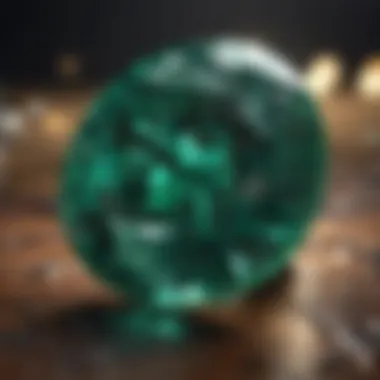
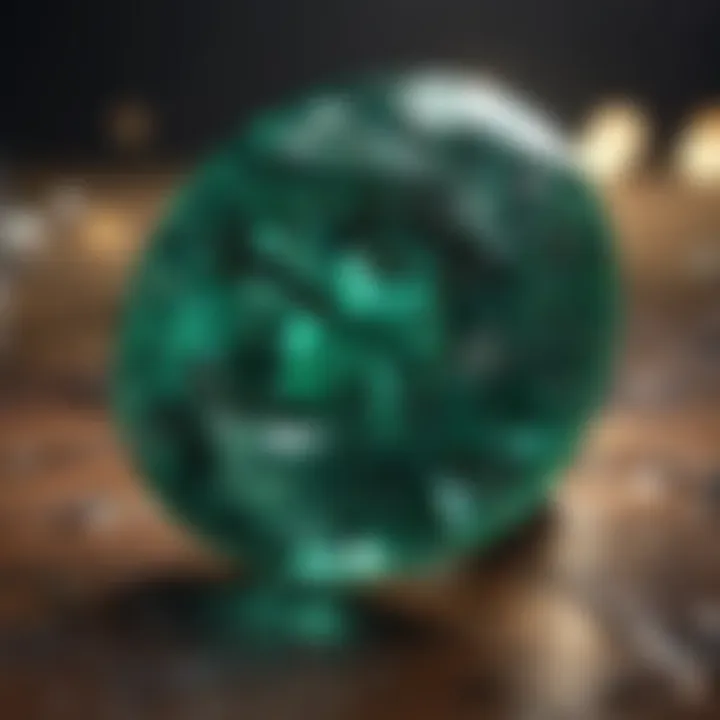
Types of Inclusions
Inclusions can best be understood as the tiny visitors nestled within gemstones. Think of them as the fingerprints of nature—each unique in their own right. Here are the prominent types:
- Crystal Inclusions: Other minerals that formed within the gemstone during its creation, like tiny windows into the geological past. For example, rutilated quartz displays needles of rutile that can be quite stunning.
- Gas and Liquid Inclusions: Bubbles of gas or pockets of liquid trapped within the gemstone. These can add character but may also detract from clarity, depending on their size and location.
- Feathers: Thin, hair-like cracks that can resemble delicate feathers inside the stone. While they might seem more like a flaw, certain stones can gain a unique dimension from them, particularly in diamonds.
- Needles: Thin, needle-like inclusions that seem to float within the stone. Certain garnets, for instance, can exhibit needle inclusions, adding a level of charm.
Understanding these types of inclusions helps in grading gemstones. For collectors, those little quirks can make all the difference in how they perceive value. Importantly, some inclusions can even be enhancements—like a storyteller enriching the narrative of the gem.
External Factors Affecting Clarity
Beside natural inclusions, external factors have their own say in the clarity game. Think of these as the weather conditions that can alter a clear blue sky into a drizzly day. Here are some of those variables:
- Cut Quality: The precision with which a gemstone is cut can tremendously influence clarity. A well-cut gemstone will reflect light masterfully, making slight inclusions less visible. On the flip side, a poorly cut stone can magnify flaws, dimming its brilliance.
- Lighting Conditions: The environment where the gemstone is displayed dramatically impacts how the clarity is perceived. Under natural daylight, inclusions may appear more prominent than under a soft, artificial light, which can soften the visual impact of any imperfections.
- Market Trends: What’s in vogue can also shape perceptions of clarity. At times, collectors might favor vintage gems—even those with visible inclusions—over something that’s completely flawless and commercially boring.
- Treatment Processes: Sometimes, gemstones undergo treatments designed to enhance clarity. While this can produce a beautiful piece, it may affect future evaluations, making it imperative for buyers to be well-informed about what methods have been employed.
As one digs deeper into the intricacies of clarity, it becomes clear that many factors cast their shadow—or light—upon a gemstone's essence. The understanding of these influences not only enriches the appreciation of gemstones but also better informs investment decisions.
Clarity and Value
When discussing gemstones, clarity is often viewed as one of the most crucial attributes that can significantly influence their worth. It is not just a matter of visual appeal but serves as a key metric in determining how valuable a gemstone is in the marketplace. A clear gemstone often has a reputation of being more desirable, primarily because it showcases the stone's inherent beauty without distractions.
A gem's clarity directly correlates to its quality. In many cases, gemstones with fewer inclusions—those tiny internal flaws or blemishes—command higher prices. Buyers are usually on the lookout for those sparkling stones that draw the eye, and clarity plays a significant role in that allure. A sparkling ruby or sapphire with crystal-clear qualities can fetch a handsome price, sometimes substantially more than its counterparts that exhibit noticeable imperfections.
Moreover, clarity isn't just a visual benefit; it highlights the gem's overall structural integrity. A well-cut stone that maintains its clarity is likely to exhibit excellent durability as well, making it a practical choice for jewelry. Thus, people who understand the nuances of clarity often make informed decisions while purchasing gemstones, considering not only immediate aesthetics but also the longevity and future value of their investments.
"In simpler terms, clarity can be the difference between a gemstone that merely looks nice and one that is truly breathtaking."
How Clarity Impacts Gemstone Pricing
The relationship between clarity and pricing is a significant aspect that gemstone enthusiasts must grasp. Pricing is not solely dependent on the gemstone type; clarity can drive costs higher or lower depending on several factors. For instance, diamonds are renowned for their clarity grading, which is pivotal in their pricing model. They are categorized into grades such as "Flawless" (F), "Internally Flawless" (IF), and grades that rank lower, such as "Very Very Slightly Included" (VVS) and down to "Included" (I). Every leap in grade can result in a sharp rise in price, a phenomenon clearly evident in the market.
- Flawless Diamonds: Generally, start at a premium because they represent the pinnacle of clarity.
- Included Gems: Often, these stones might not only be difficult to sell but can also fetch much lower market values compared to their clearer counterparts.
An example to consider is a common blue sapphire. A flawless blue sapphire might go for thousands of dollars per carat, whereas one with numerous visible inclusions could be significantly less alluring, subsequently dropping in price drastically.
In summary, clarity can set the tone for pricing; the clearer the gemstone, the higher the potential worth.
Comparative Analysis of Gemstone Value
In understanding clarity's essential role in discerning gemstone value, comparisons among various types of gems can be quite enlightening. For instance, consider the vast differences between diamonds, emeralds, and opals.
- Diamonds: Their market clearly favors clarity. The Gemological Institute of America provides standardized grading, making it easier to compare value based on clarity. A diamond that rates higher in clarity can command up to 20-50% more than a similar diamond with significant inclusions.
- Emeralds: On the flip side, emeralds often embrace inclusions as a hallmark of authenticity. Their value may not swing drastically with clarity; buyers might even prefer some inclusions due to the unique character they provide. High-quality emeralds can carry hefty price tags, but clarity isn't the sole deciding factor in this scenario.
- Opals: The clarity of opals can be elusive, as they rely heavily on their body color and play of color, rather than just the inclusions. In this light, opals with clear bodies and vivid color play can be immensely valuable, while clarity remains a secondary concern compared to other gemstones.
Through this comparative analysis, one can see how clarity’s influence on value is not uniform across the board. Each gemstone type interacts with clarity differently, creating a complex marketplace where understanding these nuances can tip the scales in favor of making an informed purchase.
Common Misconceptions about Clarity
When diving into the realm of gemstones, one swiftly encounters various myths and misunderstandings, particularly surrounding clarity. These misconceptions aren't just trivial flaws in thinking; they can lead to grave errors in judgment, affecting both appreciation and valuation of these beautiful creations of nature.
The Myth of Perfect Clarity
One prevailing misconception is the idea that perfect clarity is the gold standard for all gemstones. Many enthusiasts view the most transparent stones with no imperfections as the ideal, believing this to be the hallmark of quality.
In real life, though, nature does not always conform to these narrow definitions. Just as an artist adds unique brush strokes that tell a story, gemstones can possess inclusions – little characteristics and marks that may tell their own tale. These inclusions can be naturally occurring minerals or gas bubbles, each contributing a unique story.
"Inclusions can enhance the beauty of a stone, akin to how hashes in a painting enrich the narrative of its creation."
To further underscore this, let’s consider certain stones, such as emeralds, where some inclusions are not only common but are often embraced as part of their identity. This inherently challenges the very notion of 'perfect'. Not all who deal in gemstones are aware that some collectors even seek inclusions as they can signify uniqueness and authenticity, connecting the stone to its geological history.
Overemphasis on Clarity in Selection
Another widespread belief is that clarity should be the leading factor when selecting a gemstone. While clarity undeniably plays a role, placing undue emphasis on it can skew one’s perspective, leading to neglect of other equally important aspects such as color and cut.
For instance, a faceted amethyst may have a few inclusions, yet if the color is rich and the cut expertly executed, it can be far more appealing than a clearer but duller alternative. Here’s a breakdown of why a balanced approach matters:
- Color: In gemstones like sapphires, deep hues often overshadow the need for higher clarity. A vibrant blue can be far more captivating than a clear light-hued stone.
- Cut: A well-cut gemstone will reflect light in captivating ways, enhancing visual appeal, often compensating for minor clarity issues.
The idea that clarity alone holds the key to value and beauty can mislead both new collectors and seasoned gem buyers. Instead, they should adopt a holistic approach, treating clarity, color, and cut as interdependent elements of a gemstone’s allure.
Each facet of a stone contributes to its overall story. Striking the right balance among these qualities leads to a well-rounded appreciation of gemstones – making a more insightful investment or personal collection.
In summary, by demystifying these misconceptions surrounding clarity, gemstone enthusiasts can navigate a richer, more nuanced landscape. Embracing the complexities inherent in gemstones not only enhances the value of individual pieces but also deepens the appreciation for their diverse beauty.
Clarity and Aesthetic Appeal
When delving into gemstones, much emphasis is placed on clarity, color, and cut, yet it's often clarity that ties these elements together in a harmonious way. The interplay between clarity and aesthetic appeal is not just about how the stone looks in isolation but also how it interacts with light, enhancing or muting its natural beauty. This section aims to unpack the significance of clarity as it relates to the overall allure of gemstones.
Clarity vs. Color and Cut
In the realm of gemstones, color and cut often hog the limelight. But clarity should not be merely an afterthought. Think of a diamond: is it the mesmerizing sparkle that captures the eye more, or the subtle hints of color that might reveal its identity? When assessing a gemstone, clarity plays a pivotal role in shaping its visual narrative.
- Interdependence: Clarity can elevate colors in a gemstone. A clear sapphire can make its blue appear deeper and more vibrant. Conversely, a heavily included gemstone may dull such color, rendering it less appealing.
- Playing with Light: The cut of a stone determines how it interacts with light. A poorly cut stone, even if clear, will not produce the dazzling shimmer that a well-cut gem would. In this light, the symphony of clarity, cut, and color becomes apparent; each element should dance in harmony.
- Perceptual Focus: When looking at a gemstone, observers often fixate on imperfections when clarity is compromised. This diversion can easily sway judgments about the stone's overall value and desirability. It's the absence of distracting flaws that often allows the true beauty, color, and brilliance to shine through.
The Role of Clarity in Gemstone Jewelry
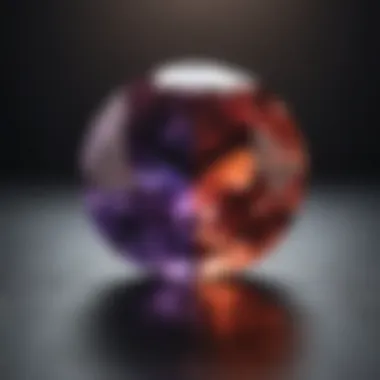
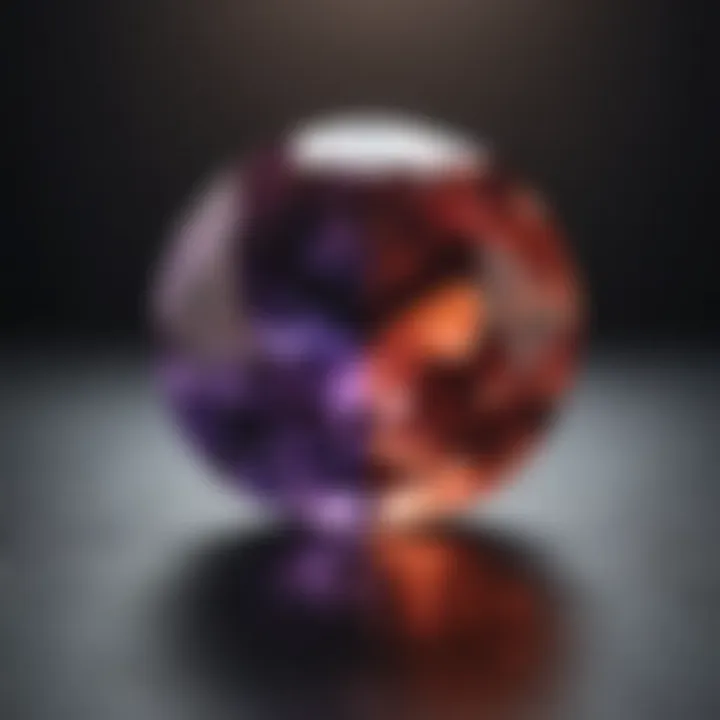
Clarity does not merely affect the gemstone itself; it extends its influence to the entire jewelry piece. Good clarity can significantly enhance the aesthetic appeal of jewelry.
- Design Considerations: Jewelers take clarity into account when designing pieces. For instance, a ring designed with a radiant-cut diamond will exhibit the stone's clarity as a significant design feature. A clear stone can be the focus, allowing the metal and style to complement rather than compete with it.
- Durability Implications: Clear stones typically feature fewer inclusions, which might compromise structural integrity. This means they are less likely to chip or break, making them ideal for everyday wear in engagement rings or frequently worn pieces.
- Desired Emotional Impact: A clear gemstone is often associated with purity and beauty. When worn, it can evoke sentiments, whether as a gift or legacy piece, where the clarity aligns with precious memories or milestones.
"In jewelry, clarity transcends mere aesthetic appeal; it possesses the power to evoke feelings and memories tied to moments significant in our lives."
Evaluating Clarity in Gemstones
Assessing clarity in gemstones is like straining honey to find the purest drop. It's crucial in understanding not just the value but also the beauty of the stone itself. Clarity influences both how light interacts with the gem and its overall aesthetic. It's an enlightening experience to discover how minor inclusions or surface blemishes can sway a stone's worth and desirability, leading collectors and enthusiasts to make informed choices. In a world where first impressions matter, clarity often lays the groundwork for a gemstone's ultimate appraisal.
Tools Used for Assessment
Determining clarity isn’t merely a guesswork game; it demands an array of specialized tools designed for precision. Here are some of the instruments typically used:
- Loupe: A 10x magnifying loupe is the standard tool for quick visual inspections. It reveals imperfections that the naked eye may overlook, making it indispensable for jewelers and gemologists.
- Microscope: For a more detailed examination, professionals turn to gemological microscopes that provide high magnification. This tool is perfect for scrutinizing complex inclusions or identifying specific types of clarity features.
- Refractometer: This tool helps in understanding how light bends within a gemstone, offering clues about its internal quality. It's less about clarity per se and more about the overall aspects that impact clarity.
- Brightness and Color Grading Linens: These are used to assess how light interacts with a gem, revealing how clear a stone appears when viewed from various angles.
"Evaluating clarity demands more than a keen eye; it requires the right tools to unlock the gemstone’s secret potential."
Each of these tools offers a different angle on clarity, turning a complex assessment into a strategic and informed process.
Visual vs. Technical Evaluation
When it comes to clarity, there's often a tug-of-war between visual and technical evaluations. Each has its own merits and drawbacks, which can significantly affect a gemstone’s perceived quality. Let’s break this down:
- Visual Evaluation: This approach is more subjective but widely used in retail settings. Through the naked eye or a loupe, one can gauge clarity based on how the gem looks in natural light. A gem with little to no visible inclusions often gets the thumbs up here. However, this style can sometimes overlook subtle imperfections only visible under magnification.
- Technical Evaluation: Here, the game changes. This method involves the use of scientific instrumentation and metrics to ascertain clarity. Measurements such as refractive index, specific gravity, and even spectroscopic analysis can reveal nuances that visual checks might miss. This method is particularly useful for high-value stones where every detail counts.
In practice, a blend of both evaluations often gives the best results. A stone might look stunning under a loupe yet reveal hidden inclusions when examined under a microscope. Thus, understanding the synergy between visual allure and technical data is essential for gemstone aficionados and collectors alike.
Cultural Perspectives on Clarity
When we talk about gemstones, clarity takes center stage, but it's fascinating to note how different cultures interpret this aspect. Understanding these cultural perspectives not only deepens our appreciation of gemstones but also sheds light on how clarity is intertwined with traditions, beliefs, and artistic expressions across the globe.
Symbolism of Clarity in Different Cultures
In many cultures, gemstones symbolize purity and perfection, often closely linked to the clarity found within. For example, in ancient Indian culture, clarity in gemstones was viewed as synonymous with spiritual enlightenment. Clear diamonds were not merely ornamentation; they represented an unbroken connection to the divine. It's believed that such brilliance captures spiritual clarity, and wearing them was thought to foster wisdom and insight.
Conversely, in Western cultures, the clarity of a gemstone often reflects societal values associated with wealth and status. People often associate a flawless gemstone with high social standing. The phrase "diamond is forever" doesn't just signify durability; it also speaks volumes about the perception of clarity as an indicator of lasting value and commitment. Here, clarity transcends the stone itself, becoming a synecdoche for one’s social and emotional investment.
- Eastern Cultures:
- Western Cultures:
- Spiritual enlightenment tied to clarity.
- An invitation for introspection and wisdom.
- Status symbol tied to wealth.
- Clarity as a sign of commitment and value.
In some Indigenous cultures, clarity isn’t the sole focus. A stone’s imperfections might hold more significance than its visible clarity. Like a personal story etched in its form, inclusions and markings can represent the journey of life. Here, authenticity is cherished over the superficial allure of clarity. These perspectives highlight that every gemstone carries a narrative, making clarity just one chapter in a larger tale.
"A gemstone is not merely a thing of beauty but a storied relic, echoing the cultural undertones shaping its value."
Historical Views on Clarity and Quality
Historically, the perception of clarity has evolved alongside advancements in gemology. In earlier times, clear elements were less understood and appreciated. The ancient Greeks, for example, considered clarity a sign of divine favor, as seen in rare instances of naturally clear gemstones. However, clarity was often not prioritized over color or size.
As the centuries progressed, the Renaissance ushered in a greater appreciation for clarity. The discovery of lapidary techniques allowed artisans to enhance the clarity of gems. During this period, clarity came to represent not only rarity but also the mastery involved in gemstone cutting.
- Ancient Perspective:
- Renaissance Shift:
- Clarity considered a divine trait.
- Not prioritized compared to size or color.
- Increased appreciation for clarity through lapidary arts.
- Sign of rarity and skilled craftsmanship.
In modern times, clarity is often quantified, impacting how stones are evaluated and priced within the gemstone market. As gemstone grading systems emerged, such as the Gemological Institute of America (GIA), clarity became an essential criterion. The clearer the stone, the more sought-after it became among investors and collectors.
Understanding these historical views informs current purchases and investments. Awareness of how societal values shape the perception of clarity can influence what people choose to collect or gift.
Clarity in Popular Gemstones
Understanding clarity in popular gemstones is essential for both collectors and enthusiasts. It’s not just about aesthetics; clarity encapsulates the gemstone's quality, price, and sometimes its origin. Gemstones like diamonds, sapphires, and emeralds, each have their own distinct clarity expectations, which can vastly influence their market value.
Key Aspects of Clarity in Popular Gemstones:
- Visual Appeal: The allure of a gemstone is often directly tied to its clarity. A clearer gem exhibits brilliance and fire, making it appears more vibrant in light.
- Investment Value: For those seeking to invest in gemstones, clarity is a critical determinant of value. Gems with higher clarity typically command higher prices.
- Market Trends: Clarity expectations can shift with trends. For instance, the recent surge in popularity of inclusions in quartz or tourmaline has altered traditional views on clarity.
Top Gemstones and Their Clarity Expectations
When it comes to clarity, different gemstones set the bar at various heights. Let’s take a closer look at some of the favorites:
- Diamond: Often touted as the benchmark for clarity, diamonds are graded on a scale from Flawless to Included. A Flawless diamond is exceedingly rare, and hence, the stakes for clarity are incredibly high.
- Sapphire: For sapphires, while clarity contributes to beauty, color often reigns supreme. However, a transparent sapphire without significant inclusions is certainly prized.
- Emerald: Contrastingly, emeralds usually contain inclusions termed “jardin.” Such inclusions are often embraced, adding character to the stone. Thus, their clarity expectations differ from those of diamonds and sapphires.
"Clarity serves as a lens through which the quality and story of a gemstone is viewed. It’s about preserving its unique character while assessing its market viability."
Rare Gemstones and Clarity Challenges
In the realm of rare gemstones, clarity becomes a rather intricate affair. Many of these gems hold intrinsic beauty, yet they come with their own clarity-related challenges:


- Tanzanite: This stunning gemstone is prized for its deep violet hues, yet it often comes with significant internal flaws. Here, clarity is overshadowed by the gem’s mesmerizing color gradients.
- Paraiba Tourmaline: Known for its electric blue shades, this gemstone often exhibits a flawed clarity. Yet, collectors are drawn to its unique coloration, often overlooking clarity imperfections.
- Alexandrite: Renowned for its color-changing abilities, alexandrite can occasionally show inclusions that affect its clarity. However, the rarity of the stone often compensates for these flaws.
In summary, clarity plays a multifaceted role in the selection and valuation of gemstones. Being vigilant about clarity not only enriches one’s appreciation but also serves as a guiding principle in the world of gemstone investment.
Clarity and Investment Potential
In the world of gemstones, clarity isn't just a measure of beauty; it plays a pivotal role in determining the investment value of these precious stones. For collectors and investors alike, understanding the nuances of clarity is essential. As the market for gemstones continues to evolve, the factors influencing clarity—and how these interactions impact overall investment decisions—are worth exploring in more detail.
Utilizing Clarity in Investment Decisions
When it comes to investing in gemstones, clarity serves as a key indicator of quality and desirability. Unlike precious metals or stocks, which have intrinsic market values, gemstones derive their worth largely from characteristics like clarity. A clearer gemstone often translates to a higher value. Thus, investors should assess clarity by considering:
- Quality Indicators: A gemstone with fewer inclusions and blemishes tends to be more valuable. This is particularly pronounced in diamonds, where clarity grades like Flawless or Internally Flawless command premium prices.
- Market Trends: Awareness of current market trends is crucial. For example, while certain stones might be favored for their clarity today, the trend could shift, affecting potential resale value.
- Comparative Analysis: Comparing similar gemstones and their clarity grades can provide guidance on what might constitute a fair price for new acquisitions.
To leverage clarity in investment decisions effectively, one must stay informed about both the industry standards and fluctuations in consumer demand.
Strategies for Investing in Clear Gemstones
Investing in clear gemstones requires a good grasp of various strategies, many of which revolve around clarity. Here are some approaches to consider when looking to make a solid investment:
- Research and Education: Knowledge is power. Delving deep into the specifics of a gemstone's clarity, such as cut and color interplay, will help investors make informed choices. Regularly consult trustworthy resources like Wikipedia or Britannica for reliable information.
- Certification: Always seek gemstones that come with certification from reputable grading labs. Certifications from organizations like the Gemological Institute of America (GIA) ensure clarity assessments are standardized and transparent.
- Diversification: Just like any good investment portfolio, it's wise to diversify. Don't put all your eggs in one basket; consider investing in a range of gemstones with varying clarity levels. For example, while diamonds might be your go-to for clarity, consider sapphires or emeralds as diversifiers.
- Long-Term Perspective: Clarity is generally stable in the long run. Investors should be prepared to hold onto their gemstones for a while, allowing their value to appreciate naturally. Quick flips can yield gains, but they also come with risks.
- Connect with Experts: Engage with gemology enthusiasts and professionals on platforms like Reddit or Facebook. These communities can provide insights and firsthand experiences that shape your investment strategy.
Investing in gemstones with a keen eye on clarity not only enhances your collection but can also yield significant financial benefits over time.
Care and Maintenance of Clarity
Taking care of gemstones isn't just about keeping them looking shiny and pristine. It's also about preserving their clarity, which holds significant importance in determining their value and visual appeal. Optimal care and maintenance not only extend the life of a gemstone but also ensure that its inherent beauty shines through, free from distracting blemishes and inclusions.
A clear gemstone often commands a higher price, and the transparent brilliance can turn heads. However, neglect in care can lead to deterioration, impacting clarity and overall aesthetic. Care encompasses cleaning, storage, and handling, and understanding these elements can make a big difference.
Best Practices for Clarity Preservation
Here are some tried-and-true methods for maintaining the clarity of your gemstones:
- Gentle Cleaning: For jewelry with stones, avoid harsh chemicals. Instead, use a mild soap solution. A soft toothbrush can help reach the crevices while being gentle on the stone.
- Proper Storage: Keep gemstones in a fabric-lined box or pouches to avoid scratching. Avoid mixing different stones together to prevent friction damage.
- Handling with Care: Always handle gemstones with clean hands to prevent oil transfer. If you're working with loose gems, wear gloves to avoid skin oils that can tarnish appearance over time.
- Regular Inspections: Inspect your gemstones periodically. Look for any signs of damage or loosening settings which may affect clarity. Early detection can prevent costly repairs.
"Proper care is not just a practice; it's an art form that reflects a respect for nature's masterpieces."
Long-term Effects of Poor Care on Clarity
Neglecting gemstone care can lead to visible consequences that diminish beauty and value:
- Accumulation of Dirt and Grime: Over time, dust and oils can build up, forming a layer that obscures clarity. This may not only dull the appearance but also attract more dirt, making future cleaning even harder.
- Scratches and Abrasions: Stones can become scratched from improper storage or handling with other gems or hard surfaces. This not only diminishes their sparkle but can also lead to further fractures that complicate repair.
- Increased Risk of Damage: Poor care can lead to loose settings or fractures that might result in losing the stone entirely. The longer these issues go unchecked, the more serious the implications.
- Value Depreciation: As the visual appeal declines due to lack of care, so does potential market value. Collectors and enthusiasts often prioritize clarity in their purchasing decisions; hence, poor care essentially results in a loss of investment.
In essence, understanding and applying these care practices keeps clarity intact and ensures that your gemstones remain the stunning focal points they are meant to be.
The Future of Clarity in Gemstones
The gemstone industry, much like a living organism, thrives on evolution. As consumer preferences shift and technology advances, the parameters that define gemstone clarity are also set to transform. Understanding these changes is crucial for enthusiasts, collectors, and industry professionals alike. Modern buyers don't just want beauty; they also demand transparency about quality and value, which makes clarity a pivotal element in the conversation around gemstones.
In addition to the aesthetic appeal, clarity is now seen as a part of ethical sourcing. As consumers become more discerning, they’re looking for stones that have passed rigorous standards of quality and environmental consideration. This opens up an array of implications:
- Increased scrutiny of certification processes
- Heightened demand for stones with verified provenance
- An emphasis on inclusivity in clarity assessment, recognizing that all stones have a story, even those with imperfections
The very essence of clarity is evolving—it's no longer about just spotting those tiny blemishes under magnification; it's a holistic view that embraces the entire journey of the stone.
Emerging Trends in Clarity Standards
As we look to the future, emerging trends regarding gemstone clarity are gaining traction within the industry. Several pivotal shifts are influencing standards and consumer expectations:
- Sustainability: Jewelers and gemologists alike are advocating for sustainable mining practices. The focus is shifting toward environmentally friendly sourcing, which includes how clarity is evaluated. Consumers are becoming more aware of ‘eco-friendly’ stones that retain clarity while being mined responsibly.
- Subjective Assessment: Traditional grading systems are being reassessed. For instance, the Gemological Institute of America (GIA) has initiated discussions around the subjective interpretation of clarity grades. This means clarity may soon be defined not just by visual inspections but also by factors like ethical sourcing and production methods related to the gem.
- Consumer Involvement: More buyers are entering the market armed with research and understanding about what clarity means. The norm is shifting towards a more informed consumer base that actively participates in discussions about gemstone clarity rather than accepting industry standards at face value.
As these trends gain momentum, they will reshape not only how clarity is understood but also how it may affect the overall market dynamics.
Technological Innovations and Clarity
Advancements in technology are reshaping the landscape of clarity assessment. New tools and methodologies are making it easier to analyze and communicate clarity qualities:
- Enhanced Imaging: Technologies like advanced 3D imaging and spectroscopy allow gemologists to see deeper into gemstones than ever before. This can highlight inclusions that were previously undetectable to the naked eye, providing a more comprehensive assessment of clarity.
- Artificial Intelligence: AI-driven tools are beginning to be integrated into clarity testing. These systems can analyze thousands of images, applying complex algorithms to compare and analyze inclusions with remarkable speed and accuracy.
- Blockchain Verification: The rise of blockchain technology offers a potential revolution in how gem quality and clarity are documented and verified. Being able to trace a gemstone's journey can add significant value and assurance for buyers, assuring them of its authenticity and ethical sourcing.
Together, these technological advancements present a promising future where clarity in gemstones can be assessed with greater precision and transparency, aligning the industry with the growing expectations of consumers.
"As clarity standards evolve, embracing technology and ethical sourcing is not merely a trend, but a necessity for the future of gemstones."
The End
In wrapping up our exploration of gemstone clarity, it becomes essential to understand why clarity holds such a pivotal role within the broader context of gemology and jewelry appreciation. Clarity is not just a technical specification; it encapsulates the very essence of what makes a gemstone desirable and valuable. By understanding the subtleties of clarity, gemstone enthusiasts can make informed choices that resonate with their aesthetic preferences and investment strategies.
Recap of Clarity's Significance
Clarity serves as a defining criterion in assessing gemstones. It dictates not only the visual appeal of a stone but also significantly affects its market value.
- Intrinsic Value: Flawless or near-flawless gemstones often command higher prices due to their rarity.
- Aesthetic Appeal: The presence of inclusions can either enhance the gemstone's unique beauty or detract from its overall visual impact. This dual nature can sometimes lead to a personal preference, depending on the individual taste of the collector or buyer.
- Investment Quality: When it comes to investment, clarity is a critical factor. Collectors typically lean towards stones with better clarity, as they tend to appreciate more over time.
"Clarity is like the lens through which a gemstone reveals its true colors, both literally and metaphorically."
In addition to these facets, our examination has also pointed out the common misconceptions that often cloud the understanding of clarity. It’s important to note that while a perfect clarity score might appear splendid on paper, it does not necessarily equate to the best choice for everyone. Often, a gemstone with some inclusions can possess character and invoke a story, adding emotional value to a piece.
Thus, clarity is not merely a checkbox on a grading report; it is interwoven with personal preference, cultural significance, and investment acumen. By keeping these considerations in mind, readers can appreciate gemstones in their multifaceted glory and navigate the intricate tapestry that is the gemstone market with more confidence.



